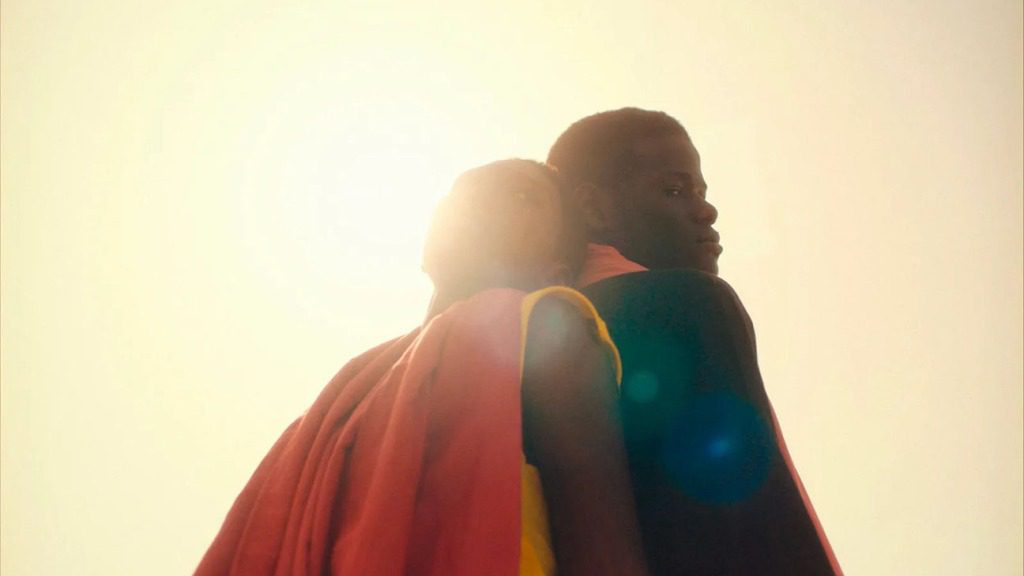Global Courant 2023-05-21 03:26:13
The notebook bears the mark of obsession: The names Banel and Adama are recorded dozens of times across pages in delicate cursive. The scribe is Banel (Khady Mane), a mercurial and expressive young woman gripped by her love for Adama (Mamadou Diallo). She whispers their names to herself like a witch casting a spell: “Banel e Adama, Banel e Adama, Banel e Adama.” Their union, she tells people in their small northern Senegalese village, is the work of fate.
It’s indeed no secret that Banel loves Adama. In the opening scenes of Ramata-Toulaye Sy’s visually arresting but narratively oblique debut feature Banel & Adama, we see the couple digging out two houses buried under layers of sand. They are working towards a dream, laboring under the oppressive sun so that they might build a home and life outside of the village. Other flashes of the daily routine gesture at the depth of their affection, with conspiratorial smiles, expectant gazes and loving caresses exchanged. Their displays are odd for the traditionally restrained people in their village. Others frown upon the couple but reserve a particular level of disdain for Banel.
Banel & Adama
The Bottom Line
A stunningly conjured world in need of a sharper story.
Venue: Cannes Film Festival (Competition)
Cast: Khady Mane, Mamadou Diallo, Binta Root Sy, Moussa Sow, Ndiabel Diallo, Oumar Samba Dia, Amadou Ndiaye
Director-screenwriter: Ramata-Toulaye Sy
1 hour 27 minutes
Banel rejects the convention, which raises suspicions among the villagers. Why does she sit with her legs crossed, like the men, instead of extended like the women? Why doesn’t she want to do laundry or tend to the field like the other wives? How is it possible, one year into her marriage to Adama, who is next in line to be chief, that Banel is still childless? These questions trail the couple like flies, buzzing as they tend to their lives. Banel and Adama ignore the disapproving looks and remarks because their love is enough. But the stakes of their relationship, as presented on screen, never quite come through. With Banel & Adama, Ramata-Toulaye Sy has conjured a stunning world in need of a sharper story.
The director’s vision is unequivocally beautiful. Sy paints breathtaking scenes with her camera, demonstrating a gorgeous way of seeing the world. Colors possess new levels of personality: The azure blue of the river where Adama and Banel take a swim early in the film glistens under the blazing sun. There’s a mischievousness to the yellow of Banel’s t-shirt when we see her watching Adama meet with the village men, all wearing complementary shades of blue. They are trying to convince him to take the position of chief, an offer he rejected in an earlier scene because of his love for Banel. Adama, whom Diallo plays with a quiet innocence, doesn’t want the responsibility.
That decision comes with consequences. After Adama turns down the role of chief, catastrophic occurrences begin taking place in the village. An extended drought kills all of the cattle, forcing the men to leave their homes for work opportunities elsewhere. People start dying off, instigating a steady procession of funerals, all of which Adama must preside over. This destruction is rendered with devastating beauty and gestures towards the deleterious effects of climate change in countries like Senegal. Sy, along with DP Amine Berrada and a laconic score by composer Bachar Mar-Khalifé, nimbly convey the progression of the village’s ruin. The arid conditions drain the sand of its color, turning what was once a desaturated orange almost white. The bodies of cattle decompose, leaving brittle and parched skin. Brown mounds mark the site of newly dug graves.
The village’s decline weakens Banel and Adama’s relationship, as the latter finds himself increasingly convinced that rejecting his post cursed his people. When Adama spends more time tending to his duties, he leaves Banel to suffer the judgmental gazes of other villagers and nurture her paranoid thoughts. Her love for Adama and anger at his absence fuels her rage, which Mane plays with chilling precision. To watch Banel unravel is one of the most interesting parts of Sy’s film. The mercurial character resembles the opaque women of novels like Toni Morrison’s Sula and Helen Oyeyemi’s Boy, Snow, Bird, a reinterpretation of “Snow White.” Like those women, Banel embodies a fierce and uncompromising independence, an intimidating self-assurance and an expressive and refreshing emotional range driven by her desire.
It’s clear that Banel will do anything to keep Adama to herself, so it’s disappointing that the fracturing of Adama and Banel’s relationship doesn’t inspire the same levels of curiosity. Sy spends so much time showing the village’s disintegration that the couple who brought us there loses out. The film falls into a sort of stupor and a languorous rhythm, losing itself in its own images.
Returning to Banel and Adama revives the pace and restores some of the tension. In one of the most haunting scenes, Banel, fed up with Adama’s inattentiveness, ushers her lover to the site of their dream home. She instructs him to dig and he does so until his hands bleed. There’s a vicious desperation at the moment, a flash of terror in Banel’s face and a flicker of fear in Adama’s. It complicates their romance and resuscitates our interest in Banel & Adama by reminding us that love is its own kind of horror.








